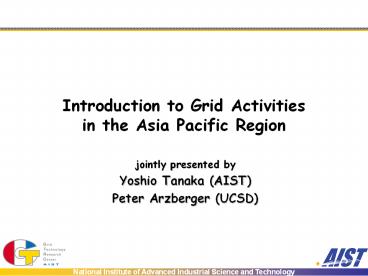Introduction to Grid Activities in the Asia Pacific Region PowerPoint PPT Presentation
Title: Introduction to Grid Activities in the Asia Pacific Region
1
Introduction to Grid Activities in the Asia
Pacific Region
- jointly presented by
- Yoshio Tanaka (AIST)
- Peter Arzberger (UCSD)
2
Outline
- What Grid make it possible?
- Attractive applications
- Introduction of Grid
- Definition
- Grid RD
- Activities in the Asia Pacific Region
- Some thoughts on Grid and P2P
- Possible interaction
3
What Grid makes it possible?
- Online Access to Remote Instruments
- Petabyte-scale Data Analysis
4
What Grid makes it possible? (contd)
- Large-scale Distributed Computing
- Large-scale Metacomputing
5
What Grid makes it possible? (contd)
- High Throughput Computing
- Integration of Human Resources
6
The Grid Problem (definition)
- Flexible, secure, coordinated resource sharing
among dynamic collections of individuals,
institutions, and resources - From The Anatomy of the Grid Enabling Scalable
Virtual Organizations
7
Elements of the Problem
- Resource sharing
- Computers, storage, sensors, networks,
- Sharing always conditional issues of trust,
policy, negotiation, payment, - Coordinated problem solving
- Beyond client-server distributed data analysis,
computation, collaboration, - Dynamic, multi-institutional virtual orgs
- Community overlays on classic org structures
- Large or small, static or dynamic
8
Research and Development on Grids
- Building Infrastructure (testbed)
- Deploy Grid-enabled resources (clusters)
- Connect with each other
- Make agreements on sociological issues
- security
- accounting
- etc.
- Software Development
- low-leve middleware
- Globus Toolkit
- high-level middleware
- MPICH-G2, Ninf-G2, Nimrod-G,
- applications
- portals / workflow
- Standardization
- Global Grid Forum
9
ApGrid Asia Pacific Partnership for Grid
Computing
North America
Europe
- International Collaboration
- Standardization
Asia
ApGrid Testbed International Grid Testbed over
the Asia Pacific countries
- ApGrid focuses on
- Sharing resources, knowledge, technologies
- Developing Grid technologies
- Helping the use of our technologies in create new
applications - Collaboration on each others work
- Possible Applications on the Grid
- Bio Informatics
- (Rice Genome, etc.)
- Earth Science
- (Weather forecast, Fluid prediction, Earthquake
prediction, etc.)
10
PRAGMA Pacific Rim Application andGrid
Middleware Assembly
http//www.pragma-grid.net
11
ApGrid/PRAGMA Testbed
- Architecture, technology
- Based on GT2
- Allow multiple CAs
- Build MDS Tree
- Grid middleware/tools from Asia Pacific
- Ninf-G (GridRPC programming)
- Nimrod-G (parametric modeling system)
- SCMSWeb (resource monitoring)
- Grid Data Farm (Grid File System), etc.
- Status
- 26 organizations (10 countries)
- 27 clusters (889 CPUs)
12
Users, Applications and Experiences
- Users
- Participants of both/either ApGrid and/or PRAGMA
- Applications
- Scientific Computing
- Quantum Chemistry, Molecular Energy Calculations,
Astronomy, Climate Simulation, Molecular Biology,
Structural Biology, Ecology and Environment, SARS
Grid, Neuroscience, Tele Science, - Experiences
- Successful resource sharing between more than 10
sites in the application level. - Lessons Learned
- We have to pay much efforts for initiation
- Installation of GT2/JobManager, CA, firewall,
etc. - Difficulties caused by the bottom-up approach
- Resources are not dedicated
- Incompatibility between different version of
software - Performance problems
- MDS, etc.
- Instability of resources
- Key issue is sociological rather than technical
13
Success Stories
- Climate Simulation using Ninf-G
- Short- to Middle-term Global climate simulation
- Run on more than 800cpus
- Joint demo with TeraGrid
- MD/QM by Nimrod-G
- New opportunities for Hybrid QM-Classical
Methods
14
Success Stories (contd)
- Trans-Pacific Grid Datafarm won Distributed
Infrastructure Award in the BWC03 - 7 sites at the US and Japan
- Aggregated BW 3.8Gbps
- Multi-Continental Telescience ownApplication
Award in the BWC03 - telescience, microscopy, biomedical informatics,
optical networking, next-generation protocols - SARS Grid
- Grid Community Pulls together to Battle
SARS - Others
- Encyclopedia of Life, Eco Grid, etc.
15
Grid versus P2P
- Basic concept is very similar
- resource sharing
- differences in technologies
- Grid
- comes from HPC
- resources
- supercomputers, clusters, special devices,
large-scale databases, etc. - security and performance are key issues
- assumes organization-level agreement for resource
sharing - PKI X.509 certificates based authentication
- programming middleware for HPC
- MPI, RPC, etc.
- P2P
- resources
- personal computers, digital contents, etc.
- de-centralized control of resources
- anonymous access is allowed
- scalability is the major advantage
16
From applications perspective
- Elements and requirements
- computation
- easy to develop applications
- easy to run applications
- easy to monitor the status of running
applications - high performance
- can expect that execution will be completed
within (estimated) limited time - data access
- easy to access
- achieve throughput as high as possible
- both computation and data accesses should be
secure
17
Interests in P2P from Grid/applications
perspective
- Volunteer computing like SETI_at_HOME is one of
success stories. - But we feel interests in data access rather
than computation. - Building data-grid using P2P technologies would
be the most attractive and practical approach as
integration of P2P and Grid. - data/contents are automatically distributed in
Grids and build networks of data/contents. - Users can access to the nearest data.
- Building contents-level Grid by integration of
P2P technologies.
18
Interests in P2P from Grid/applications
perspective (contd)
- Sensor Networks could be good testbed for P2P
theories and protocols - But sensor networks just extend information
superhighway (and grid) to the dirt road - Local computation then communication can be more
efficient than all point communication - Sensor-nets have to deal with constraint of
energy / power
19
Summary
- Grid and P2P can / should co-exist
- Applications should drive use
- APANs role
- Foster development of testbeds
- Provide capability (for large data) and capacity
(for many connections with sensor nets) - Engage applications

